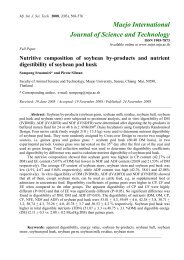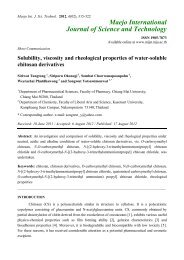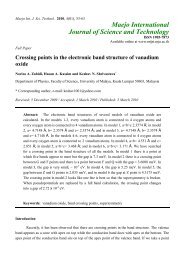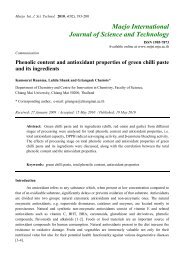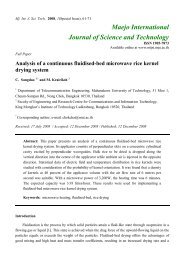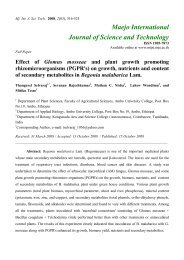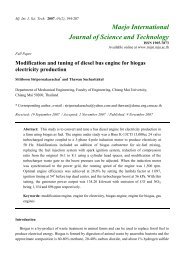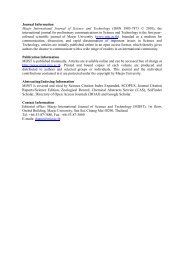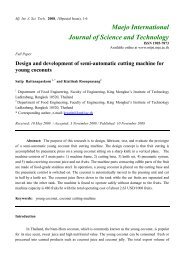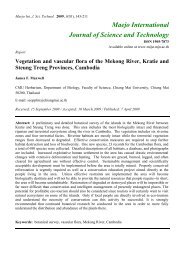Moisture sorption of Thai red curry powder - Maejo International ...
Moisture sorption of Thai red curry powder - Maejo International ...
Moisture sorption of Thai red curry powder - Maejo International ...
Create successful ePaper yourself
Turn your PDF publications into a flip-book with our unique Google optimized e-Paper software.
<strong>Maejo</strong> Int. J. Sci. Technol. 2009, 3(03), 486-497<strong>Maejo</strong> <strong>International</strong>Journal <strong>of</strong> Science and TechnologyFull PaperISSN 1905-7873Available online at www.mijst.mju.ac.th<strong>Moisture</strong> <strong>sorption</strong> <strong>of</strong> <strong>Thai</strong> <strong>red</strong> <strong>curry</strong> <strong>powder</strong>Sudathip Inchuen 1, *, Woatthichai Narkrugsa 1 and Pimpen Pornchaloempong 21 Faculty <strong>of</strong> Agro Industry, King Mongkut’s Institute <strong>of</strong> Technology Ladkrabang, Bangkok, 10520<strong>Thai</strong>land2 Department <strong>of</strong> Food Engineering, Faculty <strong>of</strong> Engineering, King Mongkut’s Institute <strong>of</strong>Technology Ladkrabang, Bangkok, 10520 <strong>Thai</strong>land* Corresponding author, Tel. +66812944469; Fax +6623264091; E-mail: sudathip4@hotmail.comReceived: 1 June 2009 / Accepted: 25 December 2009 / Published: 28 December 2009Abstract: <strong>Moisture</strong> <strong>sorption</strong> study was conducted on <strong>Thai</strong> <strong>red</strong> <strong>curry</strong> <strong>powder</strong> prepa<strong>red</strong> by twodifferent drying methods, viz. microwave and hot-air drying. <strong>Moisture</strong> <strong>sorption</strong> isotherms <strong>of</strong> the <strong>red</strong><strong>curry</strong> <strong>powder</strong> at 30 C and water activity in the range <strong>of</strong> 0.113-0.970 were determined by a staticgravimetric method. The isotherms exhibited Type III behaviour. The moisture <strong>sorption</strong> data werefitted to several <strong>sorption</strong> models and a non-linear regression analysis method was used to evaluatethe constants <strong>of</strong> the <strong>sorption</strong> equations. The fit was evaluated using the coefficient <strong>of</strong> determination(R 2 ), the <strong>red</strong>uced chi-square ( 2 ) and the root mean square error (RMSE). The GAB modelfollowed by the Lewiski-3 model gave the best fit to the experimental data. The monolayer moisturecontent, taken as the safe minimum moisture level in the <strong>red</strong> <strong>curry</strong> <strong>powder</strong>, was determined usingthe BET equation and was found to range between 0.080 - 0.085 gram water per gram dry matter.Keywords: moisture <strong>sorption</strong> isotherm, monolayer moisture content, <strong>Thai</strong> <strong>red</strong> <strong>curry</strong> <strong>powder</strong>Introduction<strong>Thai</strong> <strong>red</strong> <strong>curry</strong> paste is a well-known <strong>curry</strong> paste used to enhance several spicy <strong>Thai</strong> dishes.The paste is prepa<strong>red</strong> from dried <strong>red</strong> chili, garlic, shallot, lemon grass, galangal, spices andadditives such as salt and sugar, homogeneously blended to obtain an orange-<strong>red</strong> paste. It providesthe colourful, spicy and authentic fragrance <strong>of</strong> certain dishes. Moreover, it has been reported thatthe major ing<strong>red</strong>ients <strong>of</strong> this product such as chili [1-2], garlic [3], shallot [4], lemon grass andgalangal root [5-6] are good sources <strong>of</strong> phenolic compounds. These compounds in herbs and spiceshave been found to be major contributors to human health with multiple positive biological effects
<strong>Maejo</strong> Int. J. Sci. Technol. 2009, 3(03), 486-497487such as antioxidant activity, antimutagenic and/or anticarcinogenic activity, and anti-inflammatoryaction [7-8]. In general, the <strong>red</strong> <strong>curry</strong> paste has a high moisture content and therefore is veryperishable, having a limited shelf life. The growing popularity <strong>of</strong> <strong>Thai</strong> food around the worldcreates the need to preserve this product. Drying is one <strong>of</strong> the preservation methods that can extendthe shelf life <strong>of</strong> the <strong>red</strong> <strong>curry</strong> paste. The dried paste is milled to a <strong>powder</strong> to be used mainly as aculinary supplement and has long storage life at room temperature.During the processing and storage <strong>of</strong> agricultural products, physical, chemical andmicrobiological changes occur. The changes are influenced particularly by the moisture content andwater activity <strong>of</strong> food material. Equilibrium moisture content <strong>of</strong> a food material is defined as itsmoisture content attained when the vapour pressure <strong>of</strong> water present in the food material hasreached an equilibrium with its surroundings. It is a thermodynamic property and has practicalsignificance in both drying and storage <strong>of</strong> foods. It is affected by the relative humidity andtemperature. Water activity on the other hand is defined as the ratio <strong>of</strong> vapour pressure <strong>of</strong> waterover the foodstuff to that <strong>of</strong> pure water at the same temperature. The relationship between moisturecontent and water activity in food at constant temperature and pressure is <strong>of</strong>ten expressed as amoisture <strong>sorption</strong> isotherm. It can give information on the <strong>sorption</strong> mechanism and the interaction<strong>of</strong> food with water. The typical shape <strong>of</strong> the <strong>sorption</strong> isotherm may change depending on the type <strong>of</strong>product and reflects the way in which water binds to the system [9]. The drying method can alsosignificantly affect the <strong>sorption</strong> properties <strong>of</strong> some dry products such as model fruit <strong>powder</strong>s (driedpectin-sugar gels) [10] and dried locust bean gum-pectin-starch composite gels [11].Several equations have been used to describe the <strong>sorption</strong> isotherms <strong>of</strong> many food materials[12-16]. Some <strong>of</strong> these models are based on theories on the <strong>sorption</strong> mechanism; others are purelyempirical or semi-empirical. However, none <strong>of</strong> these equations describes accurately the <strong>sorption</strong>isotherm over the whole range <strong>of</strong> water activity or for different types <strong>of</strong> food materials. Accordingto Labuza, cited by Al-Muhtaseb et al. [12], no <strong>sorption</strong> isotherm model could fit data over theentire range <strong>of</strong> relative humidity because water is associated with the food matrix by differentmechanisms in different water activity regions.The information on the moisture <strong>sorption</strong> behaviour <strong>of</strong> food is essential for determining theinteraction <strong>of</strong> water with food substances. It is also useful for food processing operations such asdrying, mixing, packing and storage, since it can be used to calculate drying time and p<strong>red</strong>ict thebehaviour <strong>of</strong> ing<strong>red</strong>ients upon mixing. It can also help make packaging selection, model moisturechanges that occur during storage, and estimate shelf life stability [16-17]. Furthermore, themonolayer moisture content or the minimum moisture level is <strong>of</strong> importance to the physical andchemical stability <strong>of</strong> dehydrated materials with regard to lipid oxidation, enzyme activity, nonenzymaticbrowning and structural characteristics [9].The moisture <strong>sorption</strong> data for <strong>red</strong> <strong>curry</strong> <strong>powder</strong> are very rare in the literature. Therefore, inthis paper, the investigation <strong>of</strong> the equilibrated moisture content <strong>of</strong> <strong>red</strong> <strong>curry</strong> <strong>powder</strong> at variousrelative humidity values and prepa<strong>red</strong> by different drying methods is carried out. The suitability <strong>of</strong>various mathematical models for fitting the isotherm and the safe storage moisture content limits <strong>of</strong><strong>red</strong> <strong>curry</strong> <strong>powder</strong> are also evaluated.
<strong>Maejo</strong> Int. J. Sci. Technol. 2009, 3(03), 486-497488Materials and MethodsRaw materialsFresh <strong>Thai</strong> <strong>red</strong> <strong>curry</strong> paste was obtained from Namprick Maesri Partnership, Ltd. (245Petkasem Road, Nakornpathom,<strong>Thai</strong>land) and sto<strong>red</strong> at -60 ºC until use. The ing<strong>red</strong>ients <strong>of</strong> thisproduct consisted <strong>of</strong> dried <strong>red</strong> chili (35%), garlic (23%), shallot (20%), salt (7%), lemon grass (6%),spices (5%), sugar (3%) and galangal (1%). The moisture, crude fibre, ash, crude fat and protein (Nx 6.25) <strong>of</strong> the product were determined by the methods <strong>of</strong> AOAC [18] and it was found to contain70 % water, 9 % fibre, 8 % ash, 4 % fat and 3 % protein.Sample preparationThe <strong>red</strong> <strong>curry</strong> paste samples were taken out <strong>of</strong> storage and thawed at room temperature to20 o C. Fitty-five (±1) grams <strong>of</strong> the paste material were uniformly spread on a 180x180 mmtranslucent polyethylene sheet <strong>of</strong> 1-mm thickness and dried in a microwave oven (Hitachi, MR-30A, <strong>Thai</strong>land) or a hot-air oven (Path OV663, <strong>Thai</strong>land) to a final moisture content <strong>of</strong>approximately 8% by the following conditions:Microwave drying: The samples were dried at three different levels <strong>of</strong> microwave outputpower (180, 360 and 540 W) with drying time <strong>of</strong> 23, 12 and 8 min respectively.Hot-air drying: The samples were dried at three different drying temperatures (60, 70 and80 o C) with constant air velocity <strong>of</strong> 9.02 m/s and drying time <strong>of</strong> 240, 180 and 130 min respectively.Dried products were broken into small pieces, milled with an analytical mill (Retsch,ZM1000, Germany) and passed through a 0.25-mm sieve. The resulting <strong>powder</strong>s were then sealedin aluminum foil bags to prevent moisture ab<strong>sorption</strong> and sto<strong>red</strong> at -4 ºC for further studies.<strong>Moisture</strong> <strong>sorption</strong> isothermsSorption isotherms were determined by a static-gravimetric method using air-tight glass jars,each containing a saturated salt solution. The salts used were LiCl 2 , CH 3 COOK, MgCl 2 , K 2 CO 3 , KI,NaCl, KCl and K 2 SO 4 , which gave the water activity (a w ) values at 30C <strong>of</strong> 0.113, 0.216, 0.324,0.432, 0.679, 0.751, 0.836 and 0.970 respectively [9]. To determine the <strong>sorption</strong>, about 0.5 (±0.001) gram <strong>of</strong> a sample <strong>of</strong> <strong>red</strong> <strong>curry</strong> <strong>powder</strong> was accurately weighed into a previously weighedaluminum pan. The pan was then placed on a plastic receptacle inside the jar over a saturated saltsolution. The jar was then tightly closed and placed in an electric oven at 30C. At high wateractivity (a w 0.751) a small quantity <strong>of</strong> toluene was placed in a capillary tube fixed in the jar toprevent microbial spoilage <strong>of</strong> the sample [19]. All samples were weighed every week until adifference <strong>of</strong> less than 0.001 gram in two consecutive weighings was achieved, when the moisturein the sample was assumed to be at equilibrium. After the equilibrium was reached, the moisturecontent was determined using the oven method by heating at 105ºC to constant weight [18]. Alldeterminations were performed in triplicate.The experimental data <strong>of</strong> all samples were fitted to ten <strong>sorption</strong> equations (seven twoparametermodels, two three-parameter models and one four-parameter model) shown in Table 1.The parameters <strong>of</strong> the <strong>sorption</strong> models were estimated from experimental results using a non-linearregression analysis (Statistica for Windows 5.0 s<strong>of</strong>tware, StatS<strong>of</strong>t, Inc. 1984-1995).
<strong>Maejo</strong> Int. J. Sci. Technol. 2009, 3(03), 486-497489Table 1. Sorption models used for fitting experimental data [9, 12-16]Model nameModel equation(Two parameters)OswinW e =A(a w /1-a w ) BCaurie W e =exp(A+Ka w )Smith W e =A+(Bln(1-a w ))Lewicki-2 W e =A((1/a w )-1) B-1BET* W e = X m Ca w /[(1-a w )(1-a w +Ca w )]Haslay a w =exp(-A/W B e )Henderson (1-a w )=exp(-AW B e )(Three parameters)GAB W e =X m CKa w /[(1-Ka w )(1- Ka w +CKa w )]Lewicki-3 W e =A[(1/(1-a w ) B )-(1/(1+a C w ))](Four parameters)PelegW e =A(a w ) C + B(a w ) DNotes: a w = water activity; W e = moisture content at equilibrium (grams water per gram drymatter); X m = monolayer moisture content (grams water per gram dry matter); A, B, C, D and K =moisture <strong>sorption</strong> constants*Sorption data fitted for water activity 0.432Statistical analysisThe goodness <strong>of</strong> fit <strong>of</strong> tested mathematical models to the experimental data was evaluatedwith the coefficient <strong>of</strong> determination (R 2 ), <strong>red</strong>uced chi-square ( 2 ) and root mean square error(RMSE) [14-15]. The higher the R 2 value and the lower the 2 and RMSE values, the better is thefit. The 2 and RMSE can be calculated as follows:2Ni1( We,exp, i WN ze,pre ,i)2RMSE 1NNi1(We,exp,i We,pre,i)2where W e , exp,i is the i th experimental moisture content at equilibrium, W e , pre,i is the i th p<strong>red</strong>ictedmoisture content at equilibrium, N is the number <strong>of</strong> observations and z is the number <strong>of</strong> constants inthe <strong>sorption</strong> model.Results and DiscussionSorption isothermsThe initial moisture content <strong>of</strong> microwave-dried and hot-air-dried <strong>red</strong> <strong>curry</strong> <strong>powder</strong>s werefound in the range <strong>of</strong> 0.082-0.086 gram water per gram dry matter. <strong>Moisture</strong> <strong>sorption</strong> isotherms <strong>of</strong>these samples are shown in Figure 1. As the initial moisture content <strong>of</strong> the <strong>red</strong> <strong>curry</strong> <strong>powder</strong> was
<strong>Maejo</strong> Int. J. Sci. Technol. 2009, 3(03), 486-497490low, ad<strong>sorption</strong> was dominant. The equilibrated moisture content (W e ) <strong>of</strong> the <strong>red</strong> <strong>curry</strong> <strong>powder</strong>increased with water activity (a w ). This might be due to the fact that the vapour pressure <strong>of</strong> waterpresent in samples increased with that <strong>of</strong> the surroundings. The moisture content increased veryslowly with increase in water activity up to 0.432. From this point on there was a gradual increasein moisture content with increase in water activity up to 0.851, beyond which there was a steep risein moisture in all samples.MW180W MW360W MW540W HA60C HA70C HA80C4.03.5We (g water/g dry matter)3.02.52.01.51.00.50.00.0 0.1 0.2 0.3 0.4 0.5 0.6 0.7 0.8 0.9 1.0awFigure1. <strong>Moisture</strong> <strong>sorption</strong> isotherms <strong>of</strong> <strong>Thai</strong> <strong>red</strong> <strong>curry</strong> <strong>powder</strong>s prepa<strong>red</strong> by microwave drying(MW) and hot-air drying (HA)According to the classification <strong>of</strong> Brunauer et al. [12], all <strong>sorption</strong> isotherms obtainedexhibited Type III behaviour, in which a small amount <strong>of</strong> water is adsorbed at low water activityand a larger amount is adsorbed at higher water activity, and once the bulk moisture point has beenreached, the <strong>powder</strong> rapidly adsorbs large amounts <strong>of</strong> water vapour, causing it to deliquesce andleading to a steep rise in the third part <strong>of</strong> the curve, corresponding to the formation <strong>of</strong> hydrate [11].The linear shape at the first part <strong>of</strong> the isotherms is caused by water ad<strong>sorption</strong> on to thebiopolymers and the sharp increase in water content at high water activity is due to the gradualdissolution <strong>of</strong> solutes such as salts and sugars [10]. These results suggest that the <strong>red</strong> <strong>curry</strong> <strong>powder</strong>is characterised by high hygroscopicity as a result <strong>of</strong> high solute content (salt and sugar) mostly inthe amorphous state, which promotes undesirable effects (e.g. caking).Al-Muhtaseb et al. [12] reported that foods rich in soluble components show isotherms withType III behaviour owing to the solubility <strong>of</strong> the components in water. Similar isotherm behaviourhas been found in crushed chilies [14], pistachio nut paste [19], model fruit <strong>powder</strong> [10,20],
<strong>Maejo</strong> Int. J. Sci. Technol. 2009, 3(03), 486-497491pineapple pulp <strong>powder</strong> [21], fruits rich in sugar such as grape, apricot and apple [22] and saltedalligator meat [23].It is known that the shape and position <strong>of</strong> an isotherm for food is influenced by samplecomposition, physical structure (crystalline or amorphous), pretreatment and method <strong>of</strong> processing[21]. According to Figure 1, however, the effect <strong>of</strong> drying method on the shape and position <strong>of</strong> the<strong>red</strong> <strong>curry</strong> <strong>powder</strong> isotherm is not evident. This means that the states <strong>of</strong> adsorbed water <strong>of</strong> the <strong>red</strong><strong>curry</strong> <strong>powder</strong> during <strong>sorption</strong> process were not much affected by the method <strong>of</strong> drying. Moreover,all <strong>red</strong> <strong>curry</strong> <strong>powder</strong> samples had slight difference in the amount <strong>of</strong> equilibrated moisture contentover the entire water activity levels, which indicated that the drying methods did not significantlyaffect the ad<strong>sorption</strong> capacity <strong>of</strong> the samples either. Similar results were obtained by Debnath et al.[17] on freeze-dried, vacuum-shelf-dried and through-flow-dried onions. In contrast, Tsami et al.[10] found that freeze-dried pectin-sugar gels had a higher ad<strong>sorption</strong> capacity than microwavedried,vacuum-dried and convective air-dried samples in that order. Lee and Lee [24] and Giri andPrasad [25] also found that freeze-dried mushrooms had a higher ad<strong>sorption</strong> capacity thanmicrowave-dried and air-died ones in that order. Sundaram and Durance [11] found that theconvective air-dried locust bean gum-pectin-starch composite gels had a higher ad<strong>sorption</strong> capacitythan freeze-dried and microwave vacuum-dried samples in that order up to 0.8 a w level. Theseresearchers suggested that moisture <strong>sorption</strong> capacity <strong>of</strong> the dry products was in accordance withstructural properties such as shrinkage and porosity (total pore area and pore size distribution),which mainly depend on the drying method. Moreover, the effect <strong>of</strong> drying method on the <strong>sorption</strong>capacity <strong>of</strong> different materials may not be the same.Fitting <strong>of</strong> <strong>sorption</strong> models to equilibrium moisture dataThe experimental equilibrated moisture content data at any water activity <strong>of</strong> <strong>red</strong> <strong>curry</strong><strong>powder</strong> from microwave and hot-air drying methods were fitted against the water activity on tendifferent <strong>sorption</strong> models listed in Table 1. The statistical test methods, the coefficient <strong>of</strong>determination (R 2 ), the <strong>red</strong>uced chi-square ( 2 ) and the root mean square error (RMSE) were usedto select the best fitting equation. The estimated parameters and statistical analysis <strong>of</strong> the ten modelsare presented in Table 2. The results show that the highest probability <strong>of</strong> fitting the experimentaldata with the highest values for R 2 and lowest values for 2 and RMSE are obtained with the GABmodel for all the <strong>red</strong> <strong>curry</strong> <strong>powder</strong> samples. Mathematical comparison <strong>of</strong> the experimental andp<strong>red</strong>icted results gives R 2 values ranging between 0.99639-0.99753 (average 0.99696), 2 valuesranging between 0.00451-0.00580 (average 0.00504) and RMSE values ranging between 0.05308-0.06022 (average 0.05608). The fitted <strong>sorption</strong> isotherms for the model with the experimental dataare illustrated in Figure 2.Normally, parameters in the GAB equation have physical meaning: X m is the monolayercontent, C is the total heat <strong>of</strong> <strong>sorption</strong> <strong>of</strong> the first layer, and K is a factor correcting the properties <strong>of</strong>multilayer molecules with respect to the bulk liquid [19]. However, there are some other limitvalues for parameters C and K suggested by Lewicki [26] based on the mathematical analysis <strong>of</strong> themodel. In order to guarantee a relatively good description <strong>of</strong> the isotherm and to fulfill the
<strong>Maejo</strong> Int. J. Sci. Technol. 2009, 3(03), 486-497492Table 2. Statistical results and estimated values <strong>of</strong> several model parameters for different dryingconditionsModel ParameterMicrowave dryingHot-air drying180 W 360 W 540 W 60 C 70 C 80 CTwo parametersOswinA 0.33648 0.32630 0.34232 0.35039 0.34215 0.35615B 0.65178 0.66792 0.62815 0.64678 0.66175 0.61036R 2 0.98892 0.99200 0.98801 0.98878 0.99145 0.98526 2 0.01565 0.01184 0.01480 0.01662 0.01334 0.01746RMSE 0.10835 0.09425 0.10537 0.11164 0.10004 0.11443CaurieA -5.58930 -5.82891 -5.32475 -5.48757 -5.70087 -5.06514B 6.95845 7.23285 6.61666 6.87698 7.12712 6.32436R 2 0.99335 0.99274 0.99290 0.99413 0.99344 0.99440 2 0.00939 0.01075 0.00877 0.00869 0.01025 0.00662RMSE 0.08392 0.08978 0.08108 0.08074 0.08766 0.07049SmithA -0.30889 -0.32477 -0.26495 -0.31367 -0.33029 -0.24857B -0.92524 -0.94499 -0.86580 -0.94819 -0.97144 -0.85031R 2 0.94904 0.94273 0.95534 0.95187 0.94578 0.962882 0.06775 0.07996 0.05165 0.06701 0.07975 0.04109RMSE 0.22542 0.24488 0.19681 0.22418 0.24456 0.17555Lewicki-2A 0.33648 0.32630 0.34232 0.35039 0.34215 0.35615B 0.34822 0.33208 0.37185 0.35322 0.33825 0.38964R 2 0.98823 0.99152 0.98720 0.98806 0.99093 0.98422 2 0.01565 0.01184 0.01480 0.01662 0.01334 0.01746RMSE 0.10835 0.09425 0.10537 0.11164 0.10004 0.11443BETX m 0.08017 0.08339 0.08464 0.08356 0.08321 0.08287C 429.62592 145.333057 1333229.36 107.06766 1326.3384 618734.8R 2 0.96880 0.91936 0.89922 0.95998 0.87758 0.84921 2 0.00002 0.00006 0.00006 0.00003 0.00009 0.00010RMSE 0.00328 0.00566 0.00570 0.00418 0.00666 0.00723HaslayA 0.17562 0.17495 0.17492 0.18406 0.18449 0.18302B 0.91551 0.92786 0.94602 0.90163 0.91205 0.91593R 2 0.96782 0.97037 0.96476 0.97085 0.96589 0.96384 2 2.12845 1.79900 1.86518 2.76614 2.43855 2.87668RMSE 1.26346 1.16157 1.18274 1.44035 1.35237 1.46885HendersonA 1.86038 1.89811 1.87708 1.80529 1.82196 1.82029
<strong>Maejo</strong> Int. J. Sci. Technol. 2009, 3(03), 486-497493Table 2. (Continued)Model ParameterMicrowave dryingHot-air drying180 W 360 W 540 W 60 C 70 C 80 CB 0.78050 0.80097 0.81029 0.77582 0.79150 0.79160R 2 0.93792 0.94151 0.93691 0.94296 0.94013 0.94008 2 0.16648 0.23175 0.13049 0.15781 0.21300 0.08008RMSE 0.35335 0.41691 0.31283 0.34403 0.39968 0.24507Three parametersGABX m 0.51270 0.36958 0.45741 0.58185 0.42026 0.70660C 0.36373 0.55482 0.45222 0.32846 0.48915 0.28460K 0.91039 0.93380 0.90986 0.90335 0.92692 0.87733R 2 0.99658 0.99726 0.99639 0.99714 0.99753 0.99683 2 0.00580 0.00487 0.00535 0.00509 0.00463 0.00451RMSE 0.06022 0.05517 0.05781 0.05638 0.05379 0.05308Lewicki-3A 0.70377 0.62745 0.80473 0.75473 0.67691 0.96289B 0.46590 0.50227 0.41554 0.45390 0.48925 0.36552C 6.71382 6.71161 6.89649 6.75285 6.68133 7.03462R 2 0.99552 0.99672 0.99571 0.99595 0.99682 0.99576 2 0.00759 0.00582 0.00635 0.00720 0.00596 0.00603RMSE 0.06887 0.06033 0.06302 0.06706 0.06102 0.06140Four parametersPelegA 1.91516 1.98273 1.77474 1.95455 2.02753 1.71775B 1.91516 1.98273 1.77474 1.95455 2.02753 1.71775C 6.06913 6.32743 5.76744 5.99412 6.22799 5.49316D 6.06913 6.32743 5.76744 5.99412 6.22799 5.49316R 2 0.98904 0.98822 0.98782 0.98978 0.98893 0.98933 2 0.02322 0.02617 0.02256 0.02269 0.02594 0.01896RMSE 0.10776 0.11440 0.10621 0.10651 0.11388 0.09737
<strong>Maejo</strong> Int. J. Sci. Technol. 2009, 3(03), 486-497494ADWe (g water/g dry matter)3.53.02.52.01.51.00.5ExperimentalP<strong>red</strong>ictedWe (g water/g dry matter)3.53.02.52.01.51.00.5ExperimentalP<strong>red</strong>icted0.00.0 0.1 0.2 0.3 0.4 0.5 0.6 0.7 0.8 0.9 1.00.00.0 0.1 0.2 0.3 0.4 0.5 0.6 0.7 0.8 0.9 1.0Ba wEa wWe (g water/g dry matter)3.53.02.52.01.51.00.5ExperimentalP<strong>red</strong>ictedWe (g water/g dry matter)3.53.02.52.01.51.00.5ExperimentalP<strong>red</strong>icted0.00.0 0.1 0.2 0.3 0.4 0.5 0.6 0.7 0.8 0.9 1.0a w0.00.0 0.1 0.2 0.3 0.4 0.5 0.6 0.7 0.8 0.9 1.0a wCFWe (g water/g dry matter)3.53.02.52.01.51.00.5ExperimentalP<strong>red</strong>ictedWe (g water/g dry matter)3.53.02.52.01.51.00.5ExperimentalP<strong>red</strong>icted0.00.0 0.1 0.2 0.3 0.4 0.5 0.6 0.7 0.8 0.9 1.0a w0.00.0 0.1 0.2 0.3 0.4 0.5 0.6 0.7 0.8 0.9 1.0a wFigure 2. Comparison <strong>of</strong> experimental and p<strong>red</strong>icted (GAB model) <strong>sorption</strong> isotherms <strong>of</strong> <strong>Thai</strong> <strong>red</strong><strong>curry</strong> <strong>powder</strong> prepa<strong>red</strong> by microwave drying at 180 W (A), 360 W (B), 540 W (C) and hot-airdrying at 60 C (D), 70 C (E) and 80 C (F)
<strong>Maejo</strong> Int. J. Sci. Technol. 2009, 3(03), 486-497495requirements <strong>of</strong> the BET model as well as to assure that the estimated X m values differ by not morethan ± 15% from the true monolayer capacity, the above author stated that the parameters shouldassume values in the ranges 5.67 C and 0.24 K 1. In the present study, the estimated Cresults are not in accordance with the limit values and are therefore conside<strong>red</strong> as not fulfilling thetheoretical requirements. So the values <strong>of</strong> the GAB parameters obtained in this work lack anyphysical meaning. Similar results were found by Lewicki [26] for apple cellular fibre, carrot, c<strong>of</strong>fee,mushroom, wheat bran flour and yeast isotherms. The physically impossible values <strong>of</strong> the GABparameters have been reported by several researchers. The high value <strong>of</strong> X m has been reported byArslan and Toğrul [14] on the study <strong>of</strong> crushed chilies. Furthermore, the negative value <strong>of</strong> C and thevalue higher than unity <strong>of</strong> K have been found by Maskan and Göğus [19] on the study <strong>of</strong> pistachionut paste.The second best model that fits the experimental data <strong>of</strong> all the <strong>red</strong> <strong>curry</strong> <strong>powder</strong>s is theLewicki-3 model. Statistical data for the Lewicki-3 correlation are: R 2 ranging between 0.99552-0.99682 (average 0.99608), 2 ranging between 0.00582-0.00759 (average 0.00649) and RMSEranging between 0.06033-0.06362 (average 0.06362). Lewicki [24] theorised that the Lewicki-3model consists <strong>of</strong> two functions subtracted from each other assuming the two processes occur inparallel. The first process prevails at high water activity while the second plays a major role at lowwater activity. The model was found to give a higher probability <strong>of</strong> good fit for the experimentaldata compa<strong>red</strong> to the GAB and Peleg equations. Nevertheless, no physical significance could beassigned to the parameters <strong>of</strong> the equation. On the other hand, the Henderson, Haslay and Smithequations provide the worst representations <strong>of</strong> the data.Monolayer moisture contentThe value <strong>of</strong> the monolayer moisture content (X m ) is <strong>of</strong> particular interest, since it indicatesthe amount <strong>of</strong> water that is strongly adsorbed to specific sites at the food surface. It is conside<strong>red</strong> asthe optimum value to assure food stability. For most dry foods, the rate <strong>of</strong> quality loss due tochemical reactions is negligible at the monolayer value. Therefore, this value is important for thestorage <strong>of</strong> <strong>red</strong> <strong>curry</strong> <strong>powder</strong>, since at this moisture level water does not act as a solvent, beingbiologically inert.The X m value in this study was determined by using the BET equation and was found torange between 0.080-0.085 gram water per gram dry matter, the values at which the <strong>red</strong> <strong>curry</strong><strong>powder</strong> keeps very well on storage for a long period <strong>of</strong> time. Tsami et al. [10] following ad<strong>sorption</strong>at 25C found for model fruit <strong>powder</strong> the X m values between 0.060-0.097, which is the same in theorder <strong>of</strong> magnitude as X m estimated in the present work. The X m values for lemon juice andpineapple <strong>powder</strong>, however, were between 0.146-0.166 gram water per gram dry matter followingad<strong>sorption</strong> at 20-50C [16,21]. Kaymak-Ertekin and Gedik [22] found for grapes, apricots andapples X m values between 0.095-0.220 gram water per gram dry matter, and those for potatobetween 0.067-0.073 gram water per gram dry matter following ad<strong>sorption</strong> and de<strong>sorption</strong> at 30-60C. The value <strong>of</strong> X m for <strong>red</strong> <strong>curry</strong> <strong>powder</strong> thus seems to be lower than those for high-sugar fruitsand fruit <strong>powder</strong> but higher than those for starchy foods.
<strong>Maejo</strong> Int. J. Sci. Technol. 2009, 3(03), 486-497496ConclusionsThis study presents data on moisture <strong>sorption</strong> <strong>of</strong> <strong>Thai</strong> <strong>red</strong> <strong>curry</strong> <strong>powder</strong> prepa<strong>red</strong> by twodifferent drying methods, i.e. microwave drying at 180, 360 and 540 W, and hot-air drying at 60, 70and 80˚C, over a range <strong>of</strong> water activity (0.113-0.970) at 30C. It was found that the <strong>red</strong> <strong>curry</strong><strong>powder</strong> exhibited Type III <strong>sorption</strong> isotherms which were not affected by the drying methods. TheGAB model followed by the Lewicki-3 model was found to be most suitable for fitting the moisture<strong>sorption</strong> data. The monolayer moisture content derived from the BET model ranged between 0.080-0.085 gram water per gram dry matter. The moisture <strong>sorption</strong> data obtained could give usefulinformation to guide the processing, packaging and storage <strong>of</strong> <strong>Thai</strong> <strong>red</strong> <strong>curry</strong> <strong>powder</strong> at ordinarytemperature.AcknowledgementThe authors would like to thank Namprick Maesri Limited Partnership for supplying the <strong>red</strong><strong>curry</strong> paste used in this study.References1. N. Deepa, C. Kaur, B. George, B. Singh and H. C. Kapoor, “Antioxidant constituents in somesweet pepper (Capsicum annuum L.) genotypes during maturity”, LWT - Food Sci. Technol.,2007, 40, 121-129.2. M. Materska and I. Perucka, “Antioxidant activities <strong>of</strong> the main phenolic compounds isolatedfrom hot pepper fruit (Capsicum annuum L.)”, J. Agric. Food Chem., 2005, 53, 1750-1756.3. N. Leelarungrayub, V. Rattanapanone, N. Chanarat and J. M. Gebicki, “Quantitative evaluation<strong>of</strong> the antioxidant properties <strong>of</strong> garlic and shallot preparation”, Nutr., 2006, 22, 266-274.4. E. Fattorusso, M. Iorizzi, V. Lanzotti and O. Taglialatela-Scafati, “Chemical composition <strong>of</strong>shallot (Allium ascalonicum Hort.)”, J. Agric. Food Chem., 2002, 50, 5686-5690.5. T. Juntachote, E. Bergh<strong>of</strong>er, F. Bauer and S. Siebenhandl, “The application <strong>of</strong> response surfacemethodology to the production <strong>of</strong> phenolic extracts <strong>of</strong> lemongrass, galangal, holy basil androsemary”, Int. J. Food Sci. Technol., 2006, 41, 121-133.6. T. N. Ly, M. Shimoyamada, K. Kato and R. Yamauchi, “Isolation and characterization <strong>of</strong> someantioxidative compounds from the rhizomes <strong>of</strong> smaller galangal (Alpinia <strong>of</strong>ficinarum Hance)”,J. Agric. Food Chem., 2003, 51, 4924-4929.7. Y. J. Surh, “Anti-tumor promoting potential <strong>of</strong> selected spices ing<strong>red</strong>ients with antioxidativeand anti-inflammatory activities”, Food Chem. Toxicol., 2002, 40, 1091-1097.8. S. Karakaya, “Bioavailability <strong>of</strong> phenolic compounds”, Crit. Reviews Food Sci. Nutr., 2004,44, 453-464.9. L. N. Bell and T. P. Labuza, “A Textbook <strong>of</strong> <strong>Moisture</strong> Sorption”, 2nd Edn., AmericanAssociation <strong>of</strong> Cereal Chemists, Inc., St. Paul, 2000.
<strong>Maejo</strong> Int. J. Sci. Technol. 2009, 3(03), 486-49749710. E. Tsami, M. K. Krokida and A. E. Drouzas, “Effect <strong>of</strong> method drying on <strong>sorption</strong>characteristics <strong>of</strong> model fruit <strong>powder</strong>s”, J. Food Eng., 1999, 38, 381-392.11. J. Sundaram and T. D. Durance, “Water <strong>sorption</strong> and physical properties <strong>of</strong> locust bean gumpectin-starchcomposite gel dried using different drying methods”, Food Hydrocolloid, 200822, 1352-1361.12. A. H. Al-Muhtaseb, W. A. M. McMinn and T. R. A. Magee, “<strong>Moisture</strong> <strong>sorption</strong> isothermcharacteristics <strong>of</strong> food products: A review”, Trans. Inst. Chem. Eng., 2002, 80, 118-128.13. U. S. Shivhare, S. Arora, J. Ahmed and G. S. V. Raghavan, “<strong>Moisture</strong> ad<strong>sorption</strong> isotherms formushroom”, LWT - Food Sci. Technol., 2004, 37, 133-137.14. N. Arslan and H. Toğrul, “<strong>Moisture</strong> <strong>sorption</strong> isotherms <strong>of</strong> crushed chillies”, Biosyst. Eng.,2005, 90, 47-61.15. V. R. Sinija and H. N. Mishra, “<strong>Moisture</strong> <strong>sorption</strong> isotherms and heat <strong>of</strong> <strong>sorption</strong> <strong>of</strong> instant(soluble) green tea <strong>powder</strong> and green tea granules”. J. Food Eng., 2008, 86, 494-500.16. L. Martinelli, A. L. Gobas and J. Telis-Romero, “Thermodynamic and quality properties <strong>of</strong>lemon juice <strong>powder</strong> as affected by maltodextrin and Arabic gum”, Drying Technol., 2007, 25,2035-2045.17. S. Debnath, J. Hemavathy and K. K. Bhat, “<strong>Moisture</strong> <strong>sorption</strong> studies on onion <strong>powder</strong>”, FoodChem., 2002, 78, 479-482.18. K. Helrick (Ed.), “Approved Official Methods <strong>of</strong> Analysis”, 15th Edn., Association <strong>of</strong> OfficialAnalytical Chemists (AOAC), Washington, DC, 1990.19. M. Maskan and F. Göğüş, “The fitting <strong>of</strong> various models to water <strong>sorption</strong> isotherms <strong>of</strong>pistachio nut paste”, J. Food Eng., 1997, 33, 227-237.20. A. E. Drouzas, E. Tsami and G. D. Saravacos, “Microwave/vacuum drying <strong>of</strong> model fruitgels”, J. Food Eng., 1999, 39, 117-122.21. A. L. Gabas, V. R. N. Telis, P. J. A. Sobral and J. Telis-Romero, “Effect <strong>of</strong> maltodextrin andArabic gum in water vapor <strong>sorption</strong> thermodynamic properties <strong>of</strong> vacuum dried pineapple pulp<strong>powder</strong>”, J. Food Eng., 2007, 82, 246-252.22. F. Kaymak-Ertekin and A. Gedik, “Sorption isotherms and isosteric heat <strong>of</strong> <strong>sorption</strong> for grapes,apricots, apples and potatoes”, LWT - Food Sci. Technol., 2004, 37, 429-438.23. J. F. L. Filho, P. F. Romanelli, S. H. R. Barboza, A. L. Gabas and J. Telis-Romero, “Sorptionisotherms <strong>of</strong> alligator’s meat (Caiman crocodiles yacare)”, J. Food Eng., 2002, 52, 201-206.24. P. P. Lewicki, “A three parameter equation for food moisture <strong>sorption</strong> isotherms”, J. FoodProcess Eng., 1998, 21, 127-144.25. P. P. Lewicki, “The application <strong>of</strong> the GAB model to food water <strong>sorption</strong> isotherms”, Int. J.Food Sci. Technol., 1997, 32, 553-557.© 2009 by <strong>Maejo</strong> University, San Sai, Chiang Mai, 50290 <strong>Thai</strong>land. Reproduction is permitted fornoncommercial purposes.




